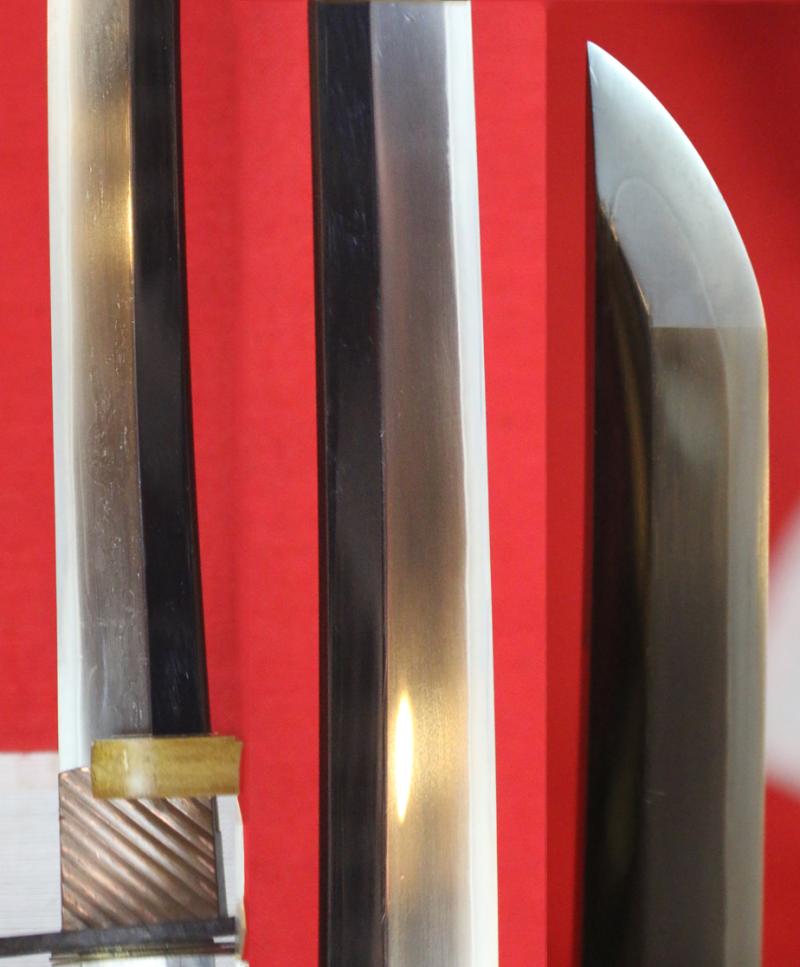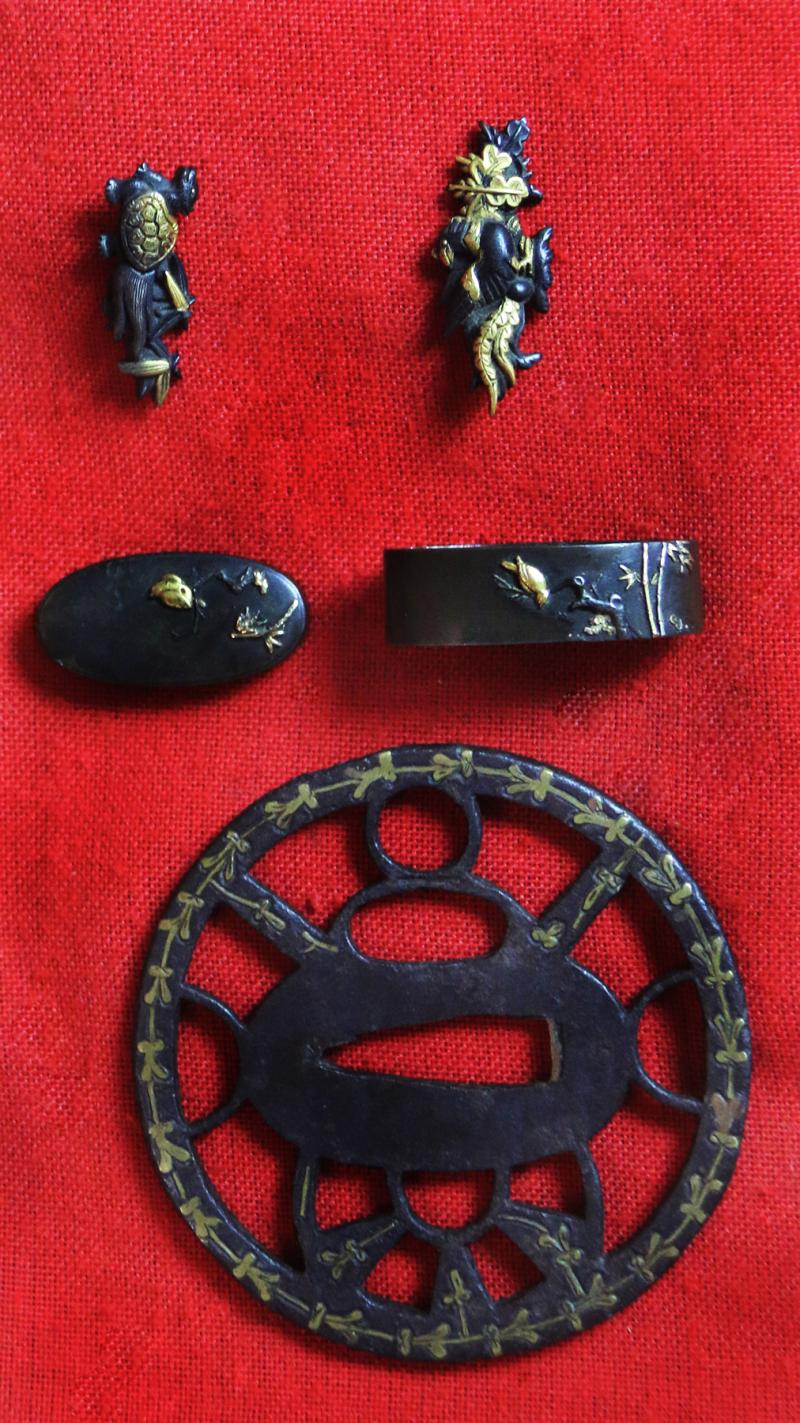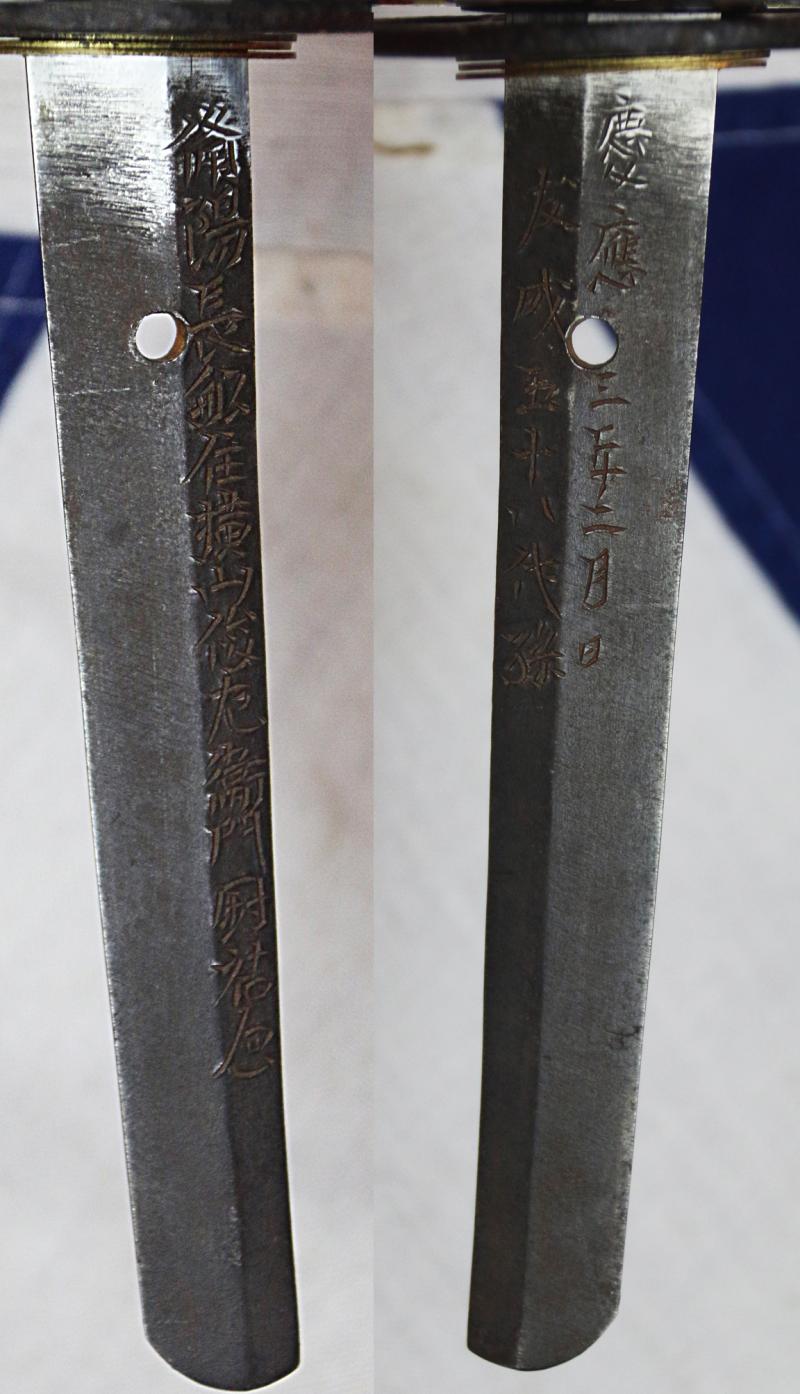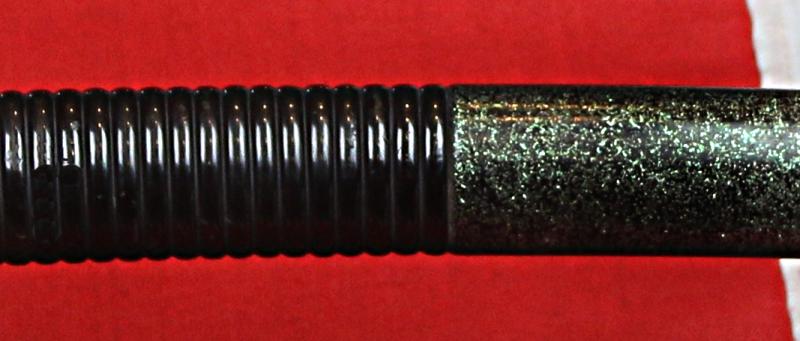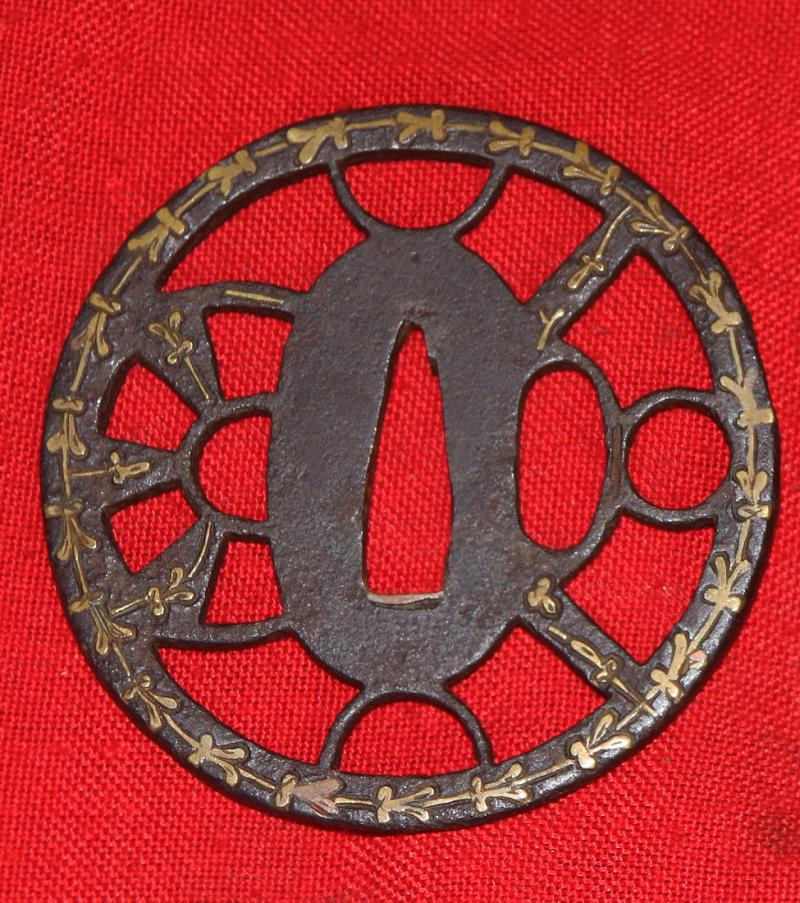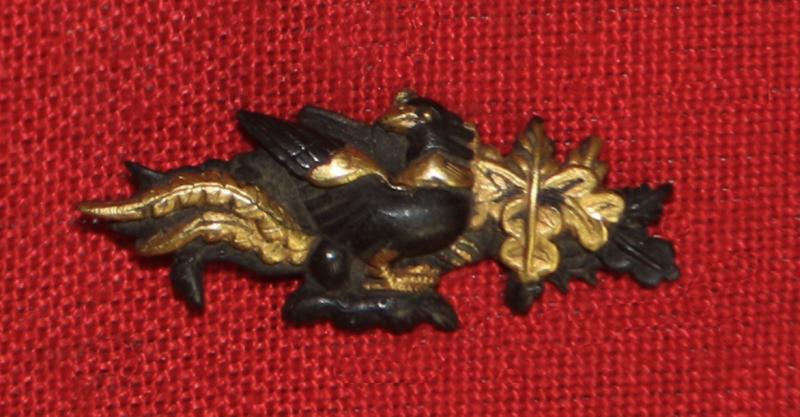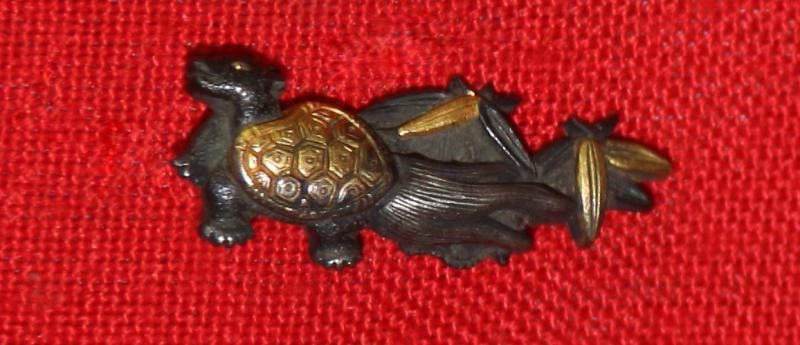A Beautiful Original Signed Bizen Yokoyama Sukekane 尉祐包 Dated February 1867, He Was The 13th Generation Sukesada & 58th Generation From The Founder of Bizen Smiths In Superb Polish With Edo Period Mounts of Shakudo & Gold by Yasuyuki 安随
Signed, 備陽長船住横山俊左衛門尉祐包
Biyo {Bishu} Osafune Jyu Yokoyama Shunzaemon Jo Sukekane
備陽長船住 is where he lives and 横山俊左衛門尉祐包 is his full name.
The 13th generation of Sukesada, who worked from 1835 to 1872, and this sword was made in the 3rd year of Keio, so it was made in February 1867.
The third says that he is the 58th grandson of the founder of Bizen smithing, Bizen Tomonari. It also shows the date of creation. Blades of the 19th-century Yokoyama school frequently declared their lineage as being directly descended from the 13th-century smith Tomonari.
It has a stunning urushi lacquered original Edo saya with ribbing on the black urushi middle top section, and crushed abilone, over green, black and clear urushi lacquer, on the top and bottom sections a most pleasing and artistic combination.
Original Edo shakudo fuchi kashira decorated with silver and gold birds, bamboo and flowers, on a hammered ground, signed Yasuyuki 安随. The tettsu tsuba has a geometric openwork design of an approaching wagon wheel with hon-zogan decoration of shinchu hira inlay. The tsuka ito {silk binding} is blue-green
A pair of superb menuki, in gold and shakudo, one is the turtle the other the phoenix. In Japanese folklore, the minogame, it is a legendary turtle of tremendous age. Sometimes living for up to 10,000 years, its most distinctive feature is the tail of seaweed and algae that trails behind it.
The most well known minogame {turtle} in Japan comes from the tale of Urashima Tarō, a legendary fisherman who rescues a turtle being tormented by children on a beach. A minogame informs him that he has actually rescued the daughter of the sea god Ryūjin, and takes him down to the bottom of the ocean to receive his thanks.
The other menuki is a Hō-ō bird . As the herald of a new age, the Hō-ō {phoenix} decends from heaven to earth to do good deeds, and then it returns to its celestial abode to await a new era. It is both a symbol of peace (when the bird appears) and a symbol of disharmony (when the bird disappears).
Some provinces of Japan were famous for their contribution to the ishime style of urushi lacquer art: the province of Edo (later Tokyo), for example, produced the most beautiful lacquered pieces from the 17th to the 18th centuries. Lords and shoguns privately employed lacquerers to produce ceremonial and decorative objects for their homes and palaces.
The varnish used in Japanese lacquer is made from the sap of the urushi tree, also known as the lacquer tree or the Japanese varnish tree (Rhus vernacifera), which mainly grows in Japan and China, as well as Southeast Asia. Japanese lacquer, 漆 urushi, is made from the sap of the lacquer tree. The tree must be tapped carefully, as in its raw form the liquid is poisonous to the touch, and even breathing in the fumes can be dangerous. But people in Japan have been working with this material for many millennia, so there has been time to refine the technique!
Flowing from incisions made in the bark, the sap, or raw lacquer is a viscous greyish-white juice. The harvesting of the resin can only be done in very small quantities.
Three to five years after being harvested, the resin is treated to make an extremely resistant, honey-textured lacquer. After filtering, homogenization and dehydration, the sap becomes transparent and can be tinted in black, red, yellow, green or brown.
Once applied on an object, lacquer is dried under very precise conditions: a temperature between 25 and 30°C and a humidity level between 75 and 80%. Its harvesting and highly technical processing make urushi an expensive raw material applied in exceptionally fine successive layers, on objects such as bowls or boxes, or as you see, samurai sword saya {scabbards}. After heating and filtering, urushi can be applied directly to a solid, usually wooden, base. Pure urushi dries into a transparent film, while the more familiar black and red colours are created by adding minerals to the material. Each layer is left to dry and polished before the next layer is added. This process can be very time-consuming and labour-intensive, which contributes to the desirability, and high costs, of traditionally made lacquer goods. The skills and techniques of Japanese lacquer have been passed down through the generations for many centuries. For four hundred years, the master artisans of Zohiko’s Kyoto workshop have provided refined lacquer articles for the imperial household. It is extraordinary that a finest urushi lacquer saya would have taken up to, and over, a year to hand produce, by some of the most finely skilled artisans in the world.
Shakudo {that can be used to make samurai sword mounts and fittings} is a billon of gold and copper (typically 4-10% gold, 96-90% copper) which can be treated to form an indigo/black patina resembling lacquer. Unpatinated shakudo Visually resembles bronze; the dark colour is induced by applying and heating rokusho, a special patination formula.
Shakudo was historically used in Japan to construct or decorate the finest katana fittings such as fuchi-kashira, tsuba, menuki, and kozuka; as well as other small ornaments. When it was introduced to the West in the mid-19th century, it was thought to be previously unknown outside Asia, but recent studies have suggested close similarities to certain decorative alloys used in ancient Egypt, Greece, and Rome.
The British Museum has a small tanto signed by the same smith Bishu Osafune Ju Yokoyama Sukekane’
https://collections.vam.ac.uk/item/O90821/dagger-and-scabbard-sukekane/
Sukekane was the 13th mainline master of the Bizen Yokoyama school, which was founded in the later 16th century by Yosozaemon no Jo Sukesada. It is said that Sukesada relocated to the nearby village of Yokoyama after the great flooding of Osafune at this time. Sukesada’s great-grandson, Sanzaemon no
Jo Sukesada, whose personal name was Toshiro and was the 4th generation, was the first representative of the school to work in shinto times.
All these smiths were named Sukesada and as they entered the shinshinto period, although they retained the character “Suke” in their names, many used a different second character instead of “Sada”. However, although living and signing their work
with Yokoyama, they appreciated that their spiritual and cultural home was still Osafune, by including this in their mei.
This is the first of two generations named Sukekane and he died in 1872, a few years after making this blade. He was taught swordmaking by one Sukenaga who was actually from a corollary family to the mainline of Yokoyama smiths. Sukenaga also signed on his nakago that he was the 56th generation descended from Tomonari. Sukenaga’s brother, Sukemori, was adopted into the mainline school, as the 12th master and Sukekane, his natural son, became the 13th master.
Code: 25542
6450.00 GBP



